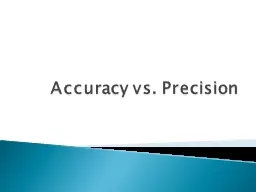

Accuracy of a measurement An indication of how close the measurement is to the accepted value Percentage difference can be calculated to give a quantitative indication of a measurements accuracythe smaller the percentage difference the greater the ID: 780605
Download The PPT/PDF document "Accuracy vs. Precision Accuracy" is the property of its rightful owner. Permission is granted to download and print the materials on this web site for personal, non-commercial use only, and to display it on your personal computer provided you do not modify the materials and that you retain all copyright notices contained in the materials. By downloading content from our website, you accept the terms of this agreement.
Slide1
Accuracy vs. Precision
Slide2Accuracy
Accuracy of a measurement:
An indication of how close the measurement is to the accepted value
Percentage difference can be calculated to give a quantitative indication of a measurement’s accuracy—the smaller the percentage difference, the greater the accuracyGood accuracy indicates low systematic error.
Slide3Precision of a Data Set
an indication of the agreement among a number of measurements made in the same way (i.e. with the same measuring tool and procedure)
The more consistent your results are, the higher the precision is
High precision implies a small amount of random error
Slide4Precision of a Measurement
An indication of how “exactly” you can measure a piece of data
More precise
measurements are those that are measured to a smaller increment of a unit of measure (i.e. more decimal places)Example: a thickness of wire measured with a meter stick will be precise to 0.05 cm; using a micrometer can increase the precision to 0.0005 cmALWAYS use a measuring tool that will give you the most appropriate precision.Absolute uncertainty can be used to indicate the precision of your measurement—more on that to come soon…
Slide5Think about this
:
Which
of these are “experimental errors”? Misreading the scale on a triple-beam balanceIncorrectly transferring data from your rough data table to the final, typed, version in your reportMiscalculating results because you did not convert to the correct fundamental unitsMiscalculations because you use the wrong equation
Slide6Were they “experimental errors”?
NONE
of these are experimental errors
They are MISTAKESWhat’s the difference?You need to check your work to make sure these mistakes don’t occur…ask questions if you need to (of your lab partner, me, etc.)Do NOT put mistakes in your error discussion in the conclusion
Slide7Experimental
Errors:
Random Errors:A result of variations in the performance of the instrument and/or the operatorDo NOT consistently occur throughout a labWhat are some examples you and your table group can think of?
Slide8random
Errors:
So what can be done
to reduce the effects of random errors?Don’t rush through your measurements! Be careful!Take as many trials as possible—the more trials you do, the less likely one odd result will impact your overall lab resultsStandard number of trials for an IB lab = 5 per manipulation (with at least 8 manipulations)
Slide9Experimental
Errors:
Systematic Errors:Errors that are inherent to the system or the measuring instrumentResults in a set of data to be centered around a value that is different than the accepted valueSome Examples:Non-calibrated (or poorly calibrated) measuring toolsA “zero offset” on a measuring tool, requiring a “zero correction” A warped ruler—results in non-symmetrical divisions
Slide10Systematic Errors:
What can be done to
the effects of
these?Unfortunately, nothing directly…unless you repeat the experiment with another piece of equipmentWe can account for the systematic errors sometimes:i.e. if there’s a zero offset, make sure all your data has been adjusted to account for that.Recognizing systematic errors will impact the size of your absolute uncertainty (details to come!)